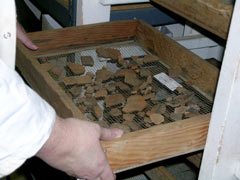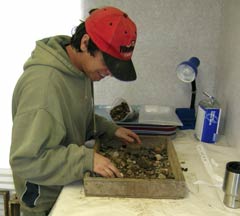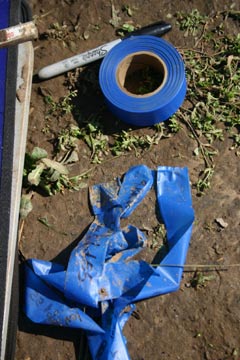


Educators:
The Georgia Department of Transportation (GDOT) has funded three sets of teaching trunks which are available to teachers for use in their classrooms. Each of these trunks are geared toward a different age group. In July 2005, Southern Research Historic Preservation Consultants, Inc. designed and constructed a teaching trunk on behalf of the Georgia Department of Transportation as part of our work at the Leake Site complex in Cartersville, Georgia. This teaching trunk is designed for elementary school-level students and is based on both real sites and on sites "created" especially for exercises for this trunk. Most activities are geared for use by one group of 5-7 students at a time. Most of the group activities have follow-up discussion or activity among the class as a whole. While Southern Research's trunk is dedicated to elementary school age children, the other two, consisting of the Teacher’s Guide, Activity Sheets, and Artifact Inventory, are appropriate for middle school and high school level individuals.
Teachers located outside the area serviced by the trunks may still find much of the information, activities, lessons, and worksheets designed for the trunk useful. Many of them do not require special materials. Educators are reminded that the dig activity is one that does not, and should not, involve actual digging. Educators are encouraged to look at the associated information and use whatever portions they find helpful in their classrooms.
To borrow the teaching trunks, contact GDOT in writing:
Georgia Department of Transportationor phone Eric Duff at (404) 699-4406 or Jim Pomfret at (404) 699-6880. Their fax number is (404) 699-4440.
Office of Environment/Location
3993 Aviation Circle
Atlanta, Georgia 30336-1593
Attn: Eric Anthony Duff
The activities in the trunk created by Southern Research teaches or reinforces various Performance Standards (GPS), [which recently replaced Georgia's Quality Core Curriculum (QCC) Standards]. for the fourth grade level. The activities are not just for fourth graders, however, and educators will undoubtedly find that they are applicable to teaching other GPS not specifically mentioned. We hope you find the information and activities in this trunk a useful and fun way to teach basic concepts while whetting your appetite and those of your students for a genuine interest in the study and preservation of the past. Activities can be used independently of each other. Students will gain the maximum benefit, however, from participating in all activities in the order presented in the Master Notebook.
Contents of the trunk include the Master Notebook that contains instructions for all activities, along with master copies for associated hand-outs. The Master Notebook also contains a duplicate set of this information copied on overhead transparencies. These can facilitate classroom discussion of various activities. Also included in the trunk are the Grid Dig Notebook, which contains instructions and master hand-out sheets for the "Grid Dig" archaeology activity; a Pottery Toolkit containing tools for decorating pottery made by the students (clay is not included in the toolkit); an Artifacts case which contains examples of archaeological artifacts from various time periods; Archaeology Concentration, a memory game made up of laminated playing card sized images; three 2D Puzzles printed with the design of vessels from Native American ceramic pots; the Frontiers in the Soil workbook and Teacher's Guide which is a valuable resource consisting of a lively and accurate cartoon book about Georgia Archaeology; and the Digging History interactive CD which enables a student to explore a real archaeology site in urban Georgia.
Unit 1: The Science of Archaeology: six lesson plans
Unit 2: Archaeological Methods: ten lesson plans
Unit 3: Georgia's Prehistoric Past: seven lesson plans
For a sample of the teacher-related material found in the trunks, please examine the following links:
The Teaching Tools: Georgia Prehistoric Archaeology Teacher Resource Kit is a 75-page Acrobat PDF file (248KB) that is downloadable here. It accompanies and amplifies the lessons covered in the trunk, and provides a framework for teachers to talk about archaeology and Georgia's prehistory.
A Nine-page set of handouts (500KB Acrobat PDF file) gives students exercises in web research, puzzle-solving, vocabulary, and how to think about problems in terms of the scientific method.
Unit: Is There A Site Here?
Lesson 1: Standalone PowerPoint presentation that can be run on a media projector or any PC. This is provided on CD-ROM. This presentation entitled "Learning About Archaeology" is designed to be used either by a classroom group or individual students (with handouts) and teaches the basics of archaeology. Vocabulary lessons include lists to be defined, a crossword puzzle, and a word search puzzle.
Lesson 2: Overview of Georgia's prehistory. A reading handout is provided entitled "A Glance at Georgia's Prehistory." Reading comprehension level for this handout is 12th grade, mainly due to the archaeology-specific vocabulary used.
Lesson 3: Optional oral quiz, with bonus questions and research activities (using the Internet) presented as oral presentations. These are group activities.
Lesson 4: Scientific method to the analysis of archaeological artifacts (some reproductions, some real). The classroom activity is done in groups.
Lesson 5: Students think creatively and critically about archaeology and the public's concept of archaeology - mainly as presented in movies. This lesson will require that the teacher be familiar with certain movies such as the Indiana Jones series, the Lara Croft series, and "Timeline."
Teachers are also provided with additional information on how to contact professional archaeologists in their area to set up classroom visits and possible field trips.


